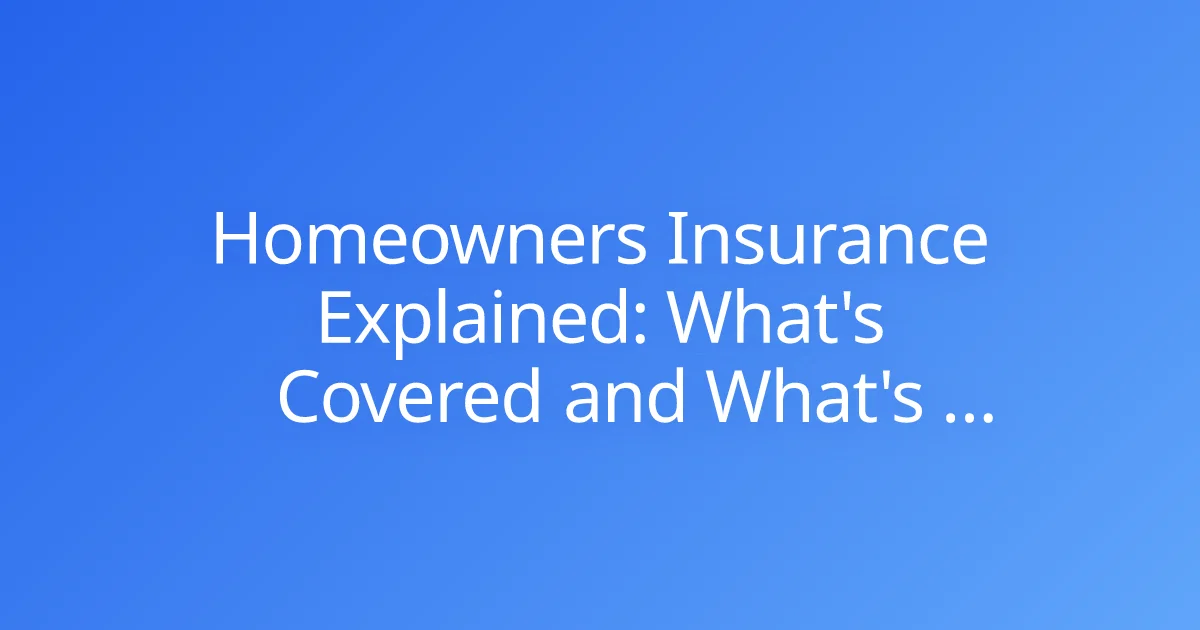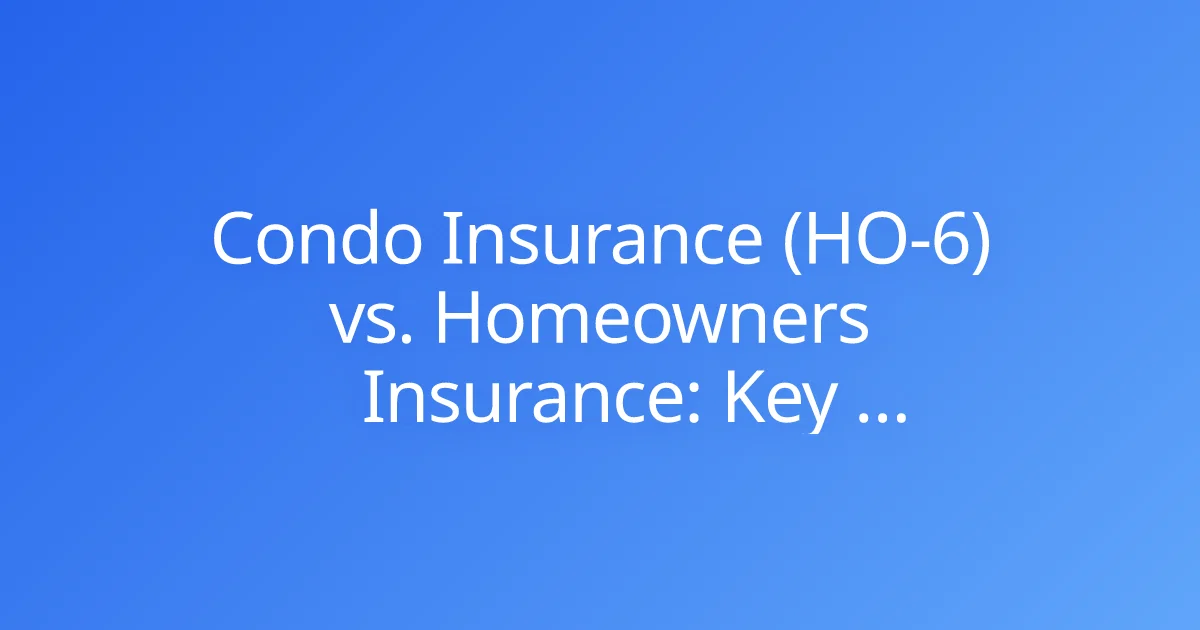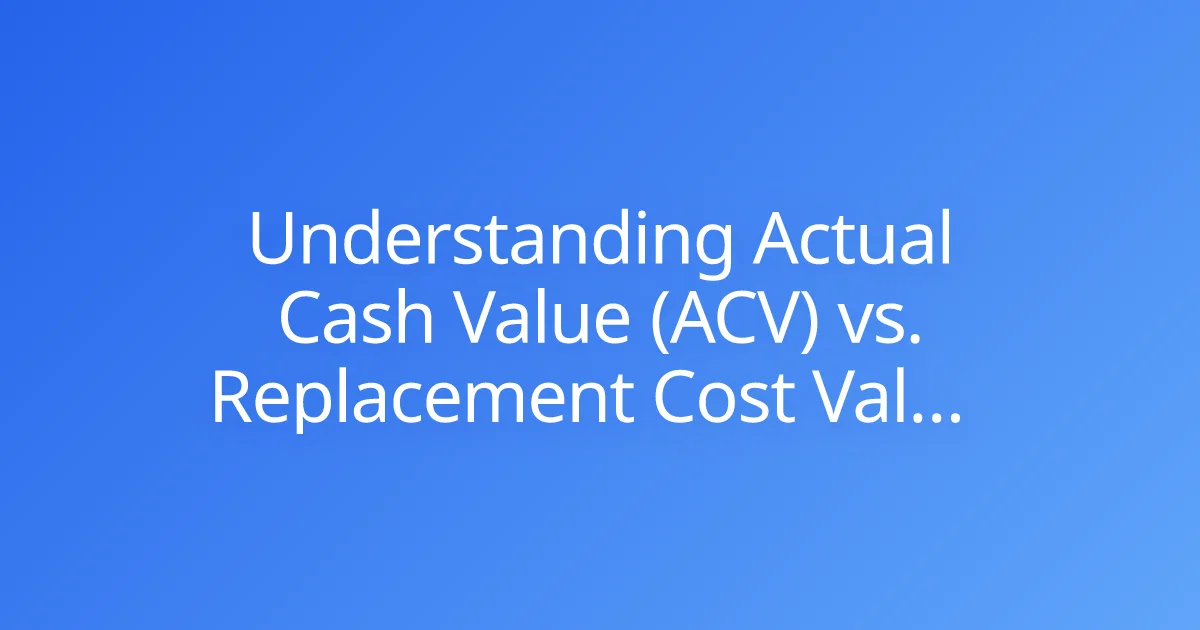How to Make a Successful Homeowners Insurance Claim After a Disaster
Experiencing a disaster – whether it's a fire, flood, hurricane, or earthquake – is a profoundly stressful event. Beyond the immediate shock and concern for safety, the daunting reality of property damage and the complex process of a homeowners insurance claim often looms large. For many, navigating this claims process feels overwhelming, riddled with jargon, and fraught with the potential for missteps that could delay or diminish your recovery.
This comprehensive guide from The Policy Explainer is designed to demystify the homeowners insurance claim journey after a disaster. We’ll walk you through crucial immediate steps, the intricacies of filing your claim, what to expect during the assessment, and how to maximize your chances of a successful claim outcome. Our goal is to empower you with the knowledge and actionable insights needed to confidently secure the coverage you deserve and begin rebuilding your life.
Immediate Steps After a Disaster
The moments immediately following a disaster are critical. Your actions during this time can significantly impact the success and speed of your homeowners insurance claim.
Prioritize Safety and Prevent Further Damage
Your safety and the safety of your loved ones is paramount. Once everyone is secure, focus on preventing additional damage to your property.
- Safety First: Do not re-enter a damaged property if it's unsafe. Follow official emergency instructions.
- Temporary Repairs: Take reasonable steps to mitigate further damage. This might include boarding up broken windows, placing tarps over damaged roofs, or shutting off utilities like water or electricity if there's a leak or exposed wiring. Keep receipts for any materials purchased; these costs are often reimbursable.
- Secure Your Property: If possible, take measures to secure your home from theft or vandalism, such as locking doors and windows, or arranging for temporary fencing.
Document Everything Extensively
Documentation is the cornerstone of any successful homeowners insurance claim. The more evidence you have, the stronger your position.
- Photos and Videos: Before any cleanup or repairs begin, take extensive photos and videos of all damage, both inside and out. Capture close-ups and wide shots. Document not only the visible damage but also the overall condition of your home and belongings before and after.
- Detailed Inventory: Create a detailed inventory of all damaged or destroyed personal property. For each item, include:
- Description (brand, model, size)
- Approximate age
- Estimated value (or original purchase price)
- Location in the home
- Any supporting documentation (receipts, appraisals, photos from before the disaster).
- Damage Estimates: Obtain written estimates from reputable contractors for necessary repairs. This provides an independent assessment of the costs involved.
Review Your Policy
Understanding your homeowners insurance policy is crucial before you even pick up the phone to file a claim.
- Coverage Types: Familiarize yourself with the specific types of coverage you have (e.g., dwelling, personal property, loss of use, other structures).
- Perils Covered: Verify that the cause of the disaster (e.g., fire, windstorm, flood) is a covered peril under your policy. Note that many standard homeowners policies exclude flood and earthquake damage, requiring separate policies.
- Deductibles: Identify your deductible amount. This is the portion of the claim you are responsible for paying before your insurer pays out.
- Policy Limits: Understand the maximum amount your insurer will pay for each type of coverage.
Initiating Your Homeowners Insurance Claim
Once immediate safety and documentation are handled, the next step is to formally notify your insurer.
Contact Your Insurer Promptly
Time is often of the essence, especially after widespread disasters.
- Reporting: Contact your insurance company as soon as reasonably possible. Many insurers have dedicated disaster hotlines or online claims portals.
- Provide Details: Be prepared to provide your policy number, a brief description of the disaster, the date and time it occurred, and a preliminary assessment of the damage.
- Ask Questions: Don't hesitate to ask about the claims process, what to expect next, and any specific documentation they require.
Understand the Claim Number and Adjuster Role
Upon filing, you'll typically receive a claim number and be assigned an insurance adjuster.
- Claim Number: This is your unique identifier for the claim. Keep it handy for all future correspondence.
- Insurance Adjuster: This is the professional appointed by your insurer to investigate your claim, assess the damage, and determine the amount of financial compensation you are entitled to under your policy. They are the primary point of contact during the assessment phase.
Navigating the Claim Assessment Process
The assessment phase is where the adjuster evaluates your reported damages. This is a critical period where clear communication and thorough preparation are key.
The Role of the Insurance Adjuster
The adjuster's job is to ensure that the claim is legitimate and that the payout aligns with the terms of your policy.
- Investigation: They will inspect the damage, review your documentation, and may interview you or other relevant parties.
- Damage Estimate: They will create their own estimate of the repair or replacement costs.
- Policy Application: They will apply the terms, conditions, and exclusions of your policy to the observed damage.
Preparing for the Adjuster's Visit
Be proactive and organized for the adjuster's inspection.
- Be Present: Try to be present during the adjuster's visit. This allows you to point out all damages, ask questions, and ensure they don't miss anything.
- Provide Your Documentation: Have all your photos, videos, inventory lists, temporary repair receipts, and contractor estimates ready to share.
- Walk Them Through: Systematically walk the adjuster through every affected area, explaining what happened and highlighting all visible and potential hidden damages.
- Be Specific: If there are items you believe were damaged but it's not immediately obvious, explain why.
Understanding Your Policy's Coverage Limits and Deductibles
After the assessment, the adjuster will begin calculating your settlement.
- Deductible Application: Your deductible will be subtracted from the total approved amount of damage.
- Depreciation vs. Replacement Cost Value (RCV): Understand if your policy pays out based on Actual Cash Value (ACV) or Replacement Cost Value (RCV). ACV deducts depreciation for wear and tear, while RCV pays the cost to replace the item with a new one of similar kind and quality (often paid in two installments: ACV first, then the depreciation holdback upon replacement). This significantly impacts your payout.
- Sub-limits: Some items (e.g., jewelry, art, electronics) may have specific sub-limits within your personal property coverage.
Maximizing Your Claim Outcome
A successful claim isn't just about getting a payout; it's about getting a fair payout that allows you to fully recover.
Keep Meticulous Records
Organization is your best friend throughout this process.
- Correspondence Log: Maintain a detailed log of all communication with your insurer and adjuster. Include dates, times, names of people you spoke with, a summary of the conversation, and any agreed-upon next steps.
- Document Copies: Keep copies of all forms, emails, letters, estimates, and receipts.
Get Independent Estimates
Don't rely solely on the adjuster's estimate.
- Multiple Quotes: Obtain at least two to three independent, detailed repair estimates from licensed and reputable contractors. These estimates should itemize labor and materials.
- Compare and Discuss: Compare your estimates with the adjuster's. If there's a significant discrepancy, discuss it with your adjuster and provide the reasons for the difference (e.g., higher quality materials, additional work needed).
Don't Rush Settlements
Be cautious about accepting the first settlement offer, especially if it feels inadequate.
- Review Thoroughly: Carefully review all settlement documents. Ensure all damaged items and necessary repairs are accounted for.
- Negotiate: If the offer is insufficient, provide clear reasons based on your documentation and independent estimates. Be prepared to negotiate.
- Consider a Public Adjuster: If negotiations stall or the claim is complex, you might consider consulting a licensed public adjuster. These professionals work exclusively for policyholders (not insurers) to help them navigate claims and secure fair settlements.
What to Do If Your Claim is Denied or Underpaid
It can be disheartening if your claim is denied or you feel the payout is insufficient. However, you have options.
Review the Denial Letter
If your claim is denied, your insurer must provide a written explanation.
- Understand the Reason: Carefully read the denial letter to understand the specific policy language or reasons cited for the denial.
- Identify Discrepancies: Compare their reasoning with your understanding of your policy and the facts of your damage.
Appeal the Decision
You have the right to appeal your insurer's decision.
- Gather More Evidence: Collect any additional documentation, expert opinions, or estimates that refute the insurer's denial reason.
- Formal Appeal: Follow your insurer's formal appeal process. This often involves submitting a written appeal letter detailing why you believe the denial is incorrect and providing supporting evidence.
Exploring Your Options for Recourse
If an internal appeal doesn't resolve the issue, further steps may be necessary.
- State Department of Insurance: You can file a complaint with your state's Department of Insurance. They regulate insurance companies and can mediate disputes.
- Legal Counsel: For significant or complex disputes, consulting with legal counsel specializing in insurance claims can provide guidance on your rights and potential legal remedies.
Receiving Your Settlement and Repairing Damage
Once an agreement is reached, the focus shifts to receiving your funds and commencing repairs.
Understanding Payment Structures
Settlements can be paid in various ways.
- Single Payment: For smaller claims, you might receive a single check.
- Multiple Payments: For larger claims, especially those involving structural repairs or personal property replacement, payments may be staggered. For RCV policies, an initial ACV payment is made, with the remaining depreciation paid upon completion of repairs or replacement of items.
- Named Payees: Checks for structural damage may be made out to both you and your mortgage lender, requiring their endorsement before funds can be released.
Managing Repairs
With the funds in hand, you can proceed with restoring your home.
- Licensed Contractors: Work with licensed, reputable contractors for all repairs.
- Documentation Continues: Keep all receipts for completed repairs and replacement items. This is particularly important for RCV policies to ensure you receive the full replacement cost.
- Final Inspection: Once repairs are complete, conduct a thorough final inspection to ensure all work meets agreed-upon standards.
Conclusion
Navigating a homeowners insurance claim after a disaster can be a challenging journey, but it doesn't have to be an insurmountable one. By understanding your policy, meticulously documenting every detail, communicating effectively with your insurer, and knowing your rights, you can significantly enhance your chances of achieving a successful claim outcome. This proactive and informed approach empowers you to secure the financial resources needed to rebuild your home and your life with confidence.
Do you have more questions about specific aspects of filing a claim or wish to share your own experiences?



